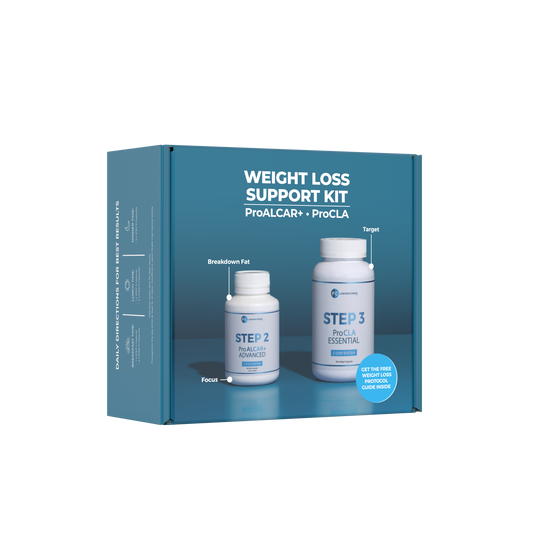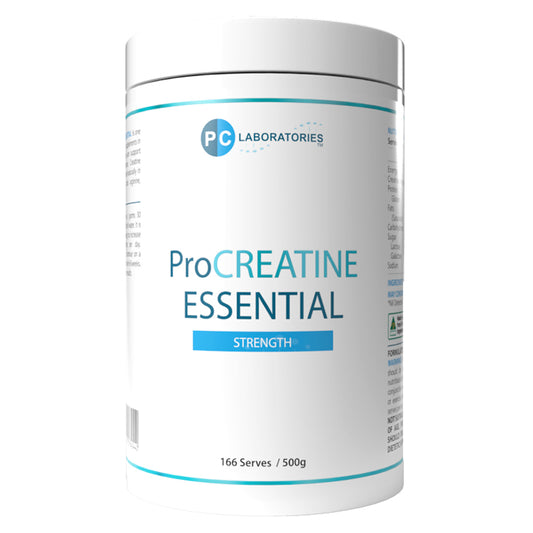The hot topic is Conjugated Linoleic Acid (CLA), an interesting fatty acid that helps to burn fat. Sounds too good to be true? Exciting news, taking CLA as a supplement has been shown in studies to affect the metabolism and to reduce energy (aka fat) accumulation.
If you’ve ever tried to lose weight, you probably know that the first few kilos usually come off with some consistent effort. But those last few? The harsh reality is that they can be a bit stubborn. You’ve cleaned up your diet, committed to your workouts, and the scale won’t budge.
This is where you may wish to explore supplement options to further progress, and one compound to consider is Conjugated Linoleic Acid, or CLA. But how effective is it, or is there real science behind it? Let’s dive into what CLA is, how it works, and why it may be a helpful tool when paired with the right regimen.
What is CLA?
Conjugated Linoleic Acid is a type of polyunsaturated fatty acid that naturally occurs in meat and dairy products, especially from grass-fed animals. It’s technically a group of isomers (molecules with the same formula but slightly different structures) derived from linoleic acid, an omega-6 fatty acid. The two most studied isomers in CLA supplements (c9, t11-CLA and t10, c12-CLA) each have their potential biological effects.
Although CLA is found in food, the amounts are relatively small. Supplements provide higher concentrations and a blend of these active isomers for greater action. Most CLA supplements are derived from safflower or sunflower oil and are used primarily for their fat-burning and body composition benefits. ProCLA Advanced is a premium source in dropper form.
Why CLA Rose To Fame
CLA gained attention in the late 1990s and early 2000s when early animal studies showed it could reduce body fat while preserving lean mass. These studies sparked interest in the athletic and weight-loss world, where fat-burning hacks are always sought after. As more research emerged, it was found that CLA may affect fat metabolism, reduce fat storage, and even modulate inflammation.
CLA has gained its appeal as a mainstream "natural" fat loss tool. Unlike harsh stimulants or fat burners that ramp up your heart rate, CLA is subtle and doesn’t usually cause jitteriness or energy crashes. That makes it a good option for people looking for a more gradual and sustainable advantage in their fitness journey.
How Does CLA Work?
The science behind CLA’s weight loss properties revolves around how it interacts with fat metabolism, energy production and inflammation. There are particular isomers believed to reduce fat storage by influencing enzymes like lipoprotein lipase (LPL), which plays a key role in fat uptake in adipose tissue. When LPL activity is inhibited, fat cells take in less fat from the bloodstream. Great news for those stubborn areas (think stomach, hips and thighs).
CLA also seems to stimulate fat oxidation, or the burning of stored fat for energy. It does this in part by influencing peroxisome proliferator-activated receptors (PPARs), a group of nuclear receptors involved in fat metabolism. By increasing receptor activity, CLA may help shift the body toward greater fat use. The key is that it must be combined with periods of caloric deficit or exercise.
This clever compound may help the programmed death of fat cells, called adipocyte apoptosis. Some studies suggest that long-term CLA use can reduce the number of fat cells, not just the size of those cells. This helps us to not only lose weight, but keep it off in the long term.
CLA and Fat Distribution
One intriguing aspect of CLA that has us excited is its potential effect on fat distribution. Some research indicates that CLA may target abdominal fat, which is typically harder to lose and more metabolically active. This may be due to the specific actions of CLA on regional fat stores and its influence on insulin sensitivity.
While CLA won’t magically “melt away” fat, it may help reduce central fat stores more effectively when used alongside a well-structured training and nutrition plan. This is especially valuable when you’re trying to lose the last 3–5 kilos, as this is the point where the body becomes more resistant to change. Our bodies are hardwired to preserve energy stores and keep us a little ‘fluffier’.
How CLA Helps Shed Kilos
Your body is intelligent and always seeking balance. As you lose weight, hormonal changes occur (like a drop in leptin levels and a rise in ghrelin) that increase hunger and slow down metabolism. This is part of your body’s survival response that kicks in the closer you get to your goal.
CLA can be helpful here by enhancing fat oxidation and preserving lean body mass, which helps maintain metabolic rate during calorie deficits. By slightly shifting the body’s fuel preference toward fat, CLA can support fat loss even when your progress seems to stall. It’s best utilised as a supportive tool to help you out of a plateau, not a shortcut to skip the hard work.
5 Lifestyle Habits That Complement CLA
To get the most out of CLA supplementation, it's essential to combine it with healthy, science-backed lifestyle habits. Here are five that can elevate your results:
1. Strength Training
Why it works: Resistance training helps preserve or build lean muscle mass, which is crucial for maintaining a higher resting metabolic rate. CLA complements this by helping retain lean mass while promoting fat loss. Studies have shown that combining CLA with resistance training can lead to more favourable changes in body composition than either intervention alone.
2. Eating More Protein
Why it works: Protein not only supports muscle maintenance but also boosts satiety and increases thermogenesis (calorie burning through digestion). High-protein diets have been shown to aid in fat loss while preserving lean mass. It keeps you satisfied, and the hangries at bay.
3. Time-Restricted Eating (TRE)
Why it works: Also known as intermittent fasting, TRE can improve insulin sensitivity and fat oxidation. Restricting food intake to an 8–10 hour window may enhance the fat-burning effects of CLA, especially if workouts are timed strategically within this window.
4. Prioritising Sleep
Why it works: Sleep regulates hormones like leptin, ghrelin, and cortisol, which influence hunger, metabolism, and fat storage. Inadequate sleep is linked to increased fat gain and impaired fat loss. CLA works best when the body is hormonally balanced, and quality sleep plays a key role in that balance.
5. Managing Stress
Why it works: Chronic stress elevates cortisol, which can lead to increased fat storage, especially in the abdominal region. CLA’s potential to target belly fat may be more effective when cortisol levels are managed through stress-reduction practices like meditation, yoga, or even light aerobic activity.
CLA Makes Progress
CLA isn’t a miracle fix, but it’s a well-researched tool that may help tip the scales—literally—when you're trying to lose those last few stubborn kilos. Its ability to support fat loss, improve fat distribution, and maintain lean mass makes it a unique addition to a fat-loss plan, especially when combined with smart lifestyle strategies.
For people who are already dialled in with their diet and training but stuck in a plateau, CLA offers a science-backed edge that could help reignite progress. It may not cause rapid weight loss, but it seems particularly helpful when targeting the most resistant fat stores and trying to preserve hard-earned muscle.
CLA is not a substitute for the foundational pillars of fat loss—caloric balance, physical activity, sleep, and stress management. It's best viewed as a supplemental ally, not the main event. Whether you’re preparing for a competition, dropping weight for health reasons, or simply trying to look and feel your best, CLA can offer metabolic support in those final stages of fat loss. Just like any other effective supplement, it works best when used consistently and in harmony with your overall health.
References
Atkinson, R. L. (1999). Conjugated linoleic acid for altering body composition and treating obesity. Nutrition Reviews, 57(5 Pt 2), S15–S18. https://doi.org/10.1111/j.1753-4887.1999.tb01752.x
Gaullier, J. M., Halse, J., Høye, K., Kristiansen, K., Fagertun, H., Vik, H., & Gudmundsen, O. (2004). Conjugated linoleic acid supplementation for 1 year reduces body fat mass in healthy overweight humans. The American Journal of Clinical Nutrition, 79(6), 1118–1125. https://doi.org/10.1093/ajcn/79.6.1118
Kreider, R. B., Ferreira, M. P., Greenwood, M., Wilson, M., & Almada, A. L. (2002). Effects of conjugated linoleic acid supplementation during training on body composition. Journal of Strength and Conditioning Research, 16(3), 325–334. https://doi.org/10.1519/00124278-200208000-00003
Park, Y., Albright, K. J., Liu, W., Storkson, J. M., Cook, M. E., & Pariza, M. W. (1997). Effect of conjugated linoleic acid on body composition in mice. Lipids, 32(8), 853–858. https://doi.org/10.1007/s11745-997-0110-x
Riserus, U., Vessby, B., Arnlov, J., & Basu, S. (2004). Effects of cis-9, trans-11 conjugated linoleic acid supplementation on insulin sensitivity, lipid peroxidation, and proinflammatory markers in obese men. The American Journal of Clinical Nutrition, 80(2), 279–283. https://doi.org/10.1093/ajcn/80.2.279
Tricon, S., Burdge, G. C., Kew, S., Banerjee, T., Russell, J. J., Jones, E. L., Yaqoob, P., & Calder, P. C. (2004). Opposing effects of cis-9, trans-11 and trans-10, cis-12 conjugated linoleic acid on blood lipids in healthy humans. The American Journal of Clinical Nutrition, 80(3), 614–620. https://doi.org/10.1093/ajcn/80.3.614
Watras, A. C., Buchholz, A. C., Close, R. N., Zhang, Z., & Schoeller, D. A. (2007). The role of conjugated linoleic acid in reducing body fat and preventing holiday weight gain. International Journal of Obesity, 31(3), 481–487. https://doi.org/10.1038/sj.ijo.0803437








